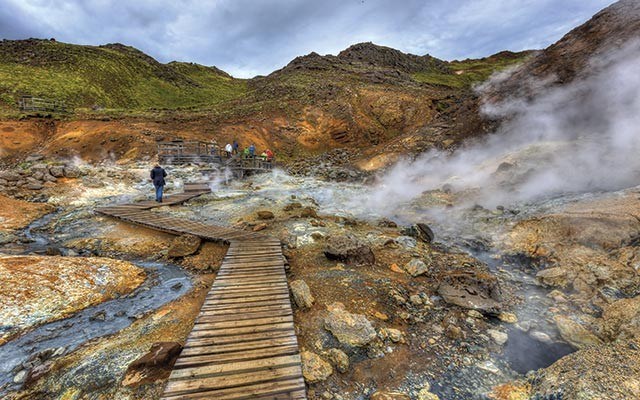Welcome to Iceland. Where a cohort of 13 Santa Clauses — scions of trolls, no less — reward children, good and bad alike, by cannibalizing them. Such a seismic divergence from mainstream European tradition reflects a cultural edginess that pervades this earthquake-riven island where volcanic volatility holds equal sway.
On a reconnaissance of the Reykjanes Peninsula, 50 kilometres from the nation's capital, Reykjavik, guide Gunnar Sigurdson explained to Pique: "The Icelandic personality is typified by the fact that the mid-Atlantic ridge between the North American and Eurasian continental plates comes ashore here on the southwestern tip of our island. As a result, we're of two minds about a lot of things, such as whether or not to join the European Union." Exhibit A: broach that subject at one's peril as Pique witnessed first hand when Sigurdson argued the point nose-to-nose with a belligerent countryman.
Who ever imagined life on the fault line between two continents could be so conflicted. Care to see for yourself? Consider this option: when your plane touches down at Iceland's Keflavik International Airport, a transatlantic hub, stick around. Icelandair permits travellers to stop over in the Nordic republic for up to a week at no extra charge. Bonus: explore with help from a like-minded local staff member with whom the airline helpfully pairs customers. (Helpfully, Icelanders are fluent English speakers.) Make plans over a meal of cod, a national mainstay, or fringe delicacies such as puffin, fermented green shark, even minke whale. Or not, as the case may be for conscience-minded epicures, Icelandic or otherwise. (One land-based entrepreneur who until three years ago ran whale-watching tours in Reykjavik's outer harbour told Pique that when whale hunting resumed in 2013 she sold her thriving business in disgust as government-sanctioned commercial whaling took place within sight of her boat.)
Together with the 2008 global financial crisis that caused three Icelandic national banks to collapse in widely-reported infamy, in 2010 a massive volcanic eruption halted international air traffic for a week and helped fix tiny Iceland (population 330,000), one of the world`s wealthiest and most developed nations, squarely in the public's eye. Where there are volcanos, there must be lava. Unlike barren lava beds dotted around the Coast Mountains in places such as Garibaldi Provincial Park's Diamond Head region in Squamish, the Icelandic landscape more closely resembles rolling green expanses characteristic of New Zealand and Ireland. Mosses, heathers, and a potpourri of mountain herbs, notably thyme, carpet and smooth the edges of lava fields on which free-range sheep feed. Serendipitously, Pique arrived in the peninsula seaside town of Grindavik in mid-September when farmers astride sturdy Icelandic horses wrangled moving currents of woolly livestock from summer grazing areas into holding pens for shearing or slaughter.
The lava-draped Reykjanes Peninsula lies astride the mid-Atlantic Ridge, one of the world's major tectonic plate boundaries. Continental drift theory holds that Eurasian and North American tectonic plates are continuously sliding apart. Due to stresses created by the tension that builds up as the plates move away from each other, linear fractures, known as fissures, form. Where the ridge comes ashore at Cove Sandvik, the gap is increasing at a rate of two centimetres or almost an inch a year. Doesn't sound like much until measured in deep geologic time. There's no place better to gauge this slow but relentless divide than in the fissure's shallow trench, a short hop down from an interpretive trail constructed for visitors. A pedestrian walkway, dubbed Leif the Lucky's Bridge, spans the two continents. Grab a handful of black sand and revel as tactile evidence of the Earth's primordial past slips through your fingers.
When the ocean goes glassy, Icelanders like to say the North Atlantic is calm as cream. Not on the day Pique ventured across a windswept plateau beside the ridge on the Hafnerberg cliffs. Towering wave trains tossed bull kelp and spindrift against the granite bulwark watched over by oversized sculptures of two brooding ravens, Huginn and Muninn. Their mythological duties were to deliver daily reports to Odin, the one-eyed, long-bearded Norse overseer of both earthly affairs and the heavenly hall of slain warriors, Valhalla. From here, sometime around 1000 A.D., the ravens would have witnessed sailors led by Leif Eriksson stage the first of several Viking expeditions to the North American coast, venturing as far south as the Gulf of St. Lawrence long before like-minded European explorers such as Jacques Cartier and Samuel de Champlain set off.
As the tempest drove rain in sideways, Pique sought refuge nearby at the Reykjanesvirkjun geothermal power station, home to a creatively-designed alternative-fuel science centre — Power Plant Earth. The power plant, emblematic of geothermal generating stations dotted throughout the country, opened in 2006 and sits atop a system of pipes that extend below ground into which thermal water is injected until it vaporizes into steam. In turn, the steam rises and drives hydroelectric turbines, as close to perpetual motion as energy generations gets. And what better place to drill through the earth's mantle than here on the mid-Atlantic Ridge. (Interesting to note that, since the 1970s, both BC Hydro and privately financed concerns have explored similar ways to tap into geothermal power at the base of Mount Meager northwest of Pemberton.) Thanks to its geothermal underpinnings, Iceland runs almost entirely on renewable energy. Around these parts, ice is nice, but thermal's eternal.
Access:
For travel and related information on the Reykjanes Peninsula, visit www.visitreykjanes.is; www.icelandtravel.is; www.icelandnaturally.com; and www.islandtourismboard.com. Details on Icelandair Stopover Buddy Service are posted at www.icelandair.ca. Note: In January, Reykjavik topped Rough Guide's Top 10 Cities for 2016 list over runners-up Mexico City and Seoul. Vancouver ranked 9th.
Pique contributor Jack Christie is the author of The Whistler Book. For more information, visit www.jackchristie.com




